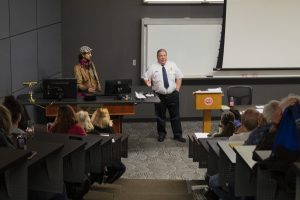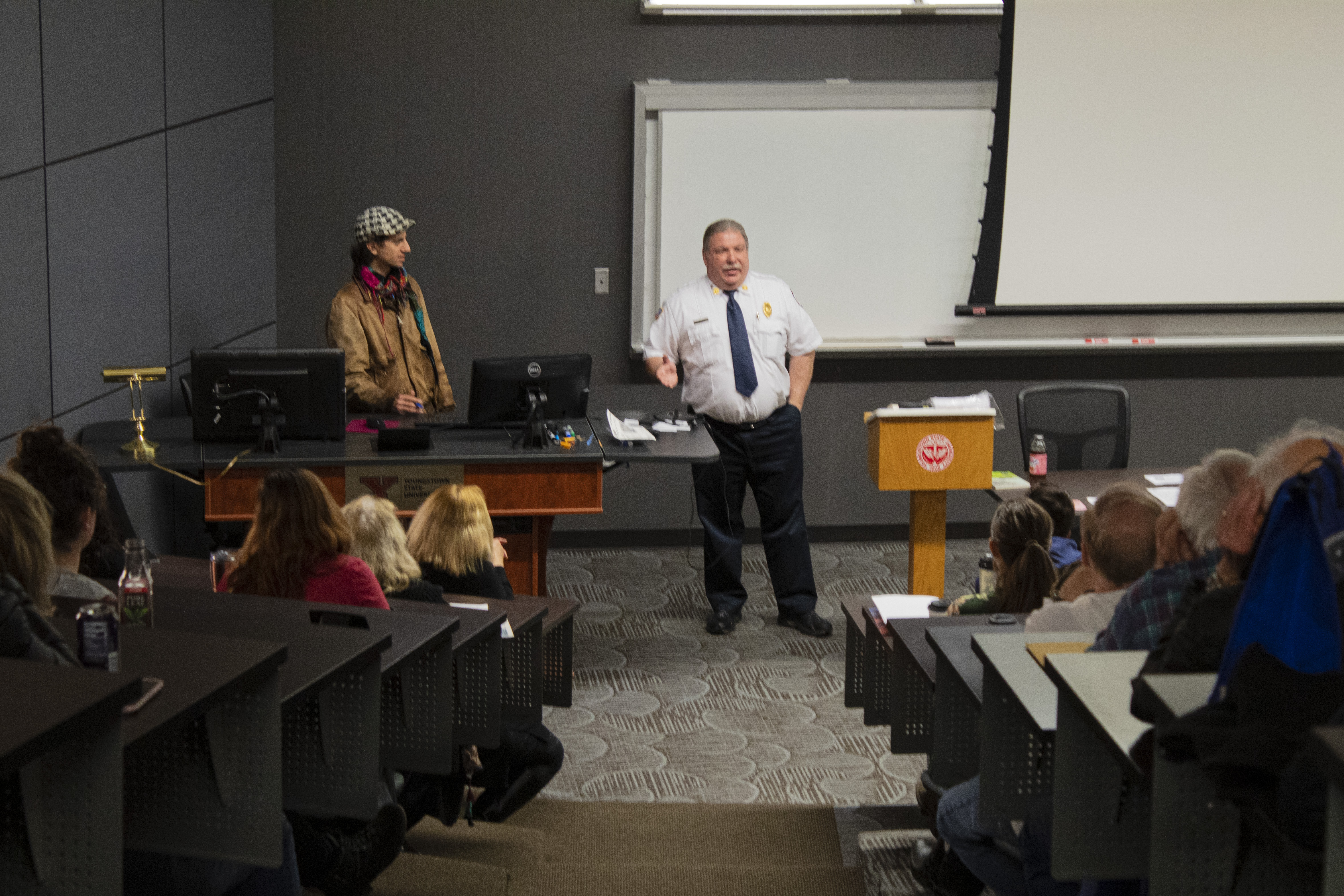By J. Harvard Feldhouse
Justin Nobel, environment reporter for Rolling Stone magazine, and Sil Caggiano, Youngstown senior fire battalion chief, visited Youngstown State University’s campus Saturday to discuss Nobel’s recent revealing article of the oil and gas industry.
Nobel’s article, titled “America’s Radioactive Secret,” revealed that oil and gas companies covered up the fact that brine, a saline byproduct of Marcellus Shale fracking, contains high levels of radium-224 and radium-226, radioactive isotopes.
According to the article, workers at oil and gas wells have been exposed to the radioactive brine without being told and without proper hazmat training and equipment. Workers have experienced nausea, sores and, in some cases, cancer.
Nobel stated, “The Nuclear Regulatory Commission requires industrial discharges to remain below 60 [picocuries per liter of substance].” But when an anonymous brine truck driver took samples of brine to universities for testing, the samples yielded levels from 3,500 to 8,500 picocuries per liter.
Further than that, brine has also been sold to municipalities and commercially to people as a de-icer called AquaSalina. Cleveland MetroParks has been known to use it in the past.
Tish O’Dell, board member of the Ohio Community Rights Network and co-organizer of the lecture, is on the front lines of anti-AquaSalina advocacy. When she spoke out about it two years ago, the company, Nature’s Own Source, sued her for defamation.
O’Dell reached out to professors in YSU’s Department of Geological and Environmental Science, such as Colleen McLean, Susie Beiersdorfer and the late Ray Beiersdorfer, in order to get solid evidence against AquaSalina.
“I had known about radioactivity in brine and the brine trucks but was shocked to hear that this radioactive product was being sold commercially,” Susie Beiersdorfer said.
O’Dell told Nobel about AquaSalina two years ago, inspiring him to pursue the story.

“Justin contacted me in May of 2018 about a story he was doing about industrial wind projects, and somehow the brine conversation came up — I don’t even remember how,” O’Dell said. “I told him some of the preliminary results coming in from Dr. Ray’s connections and some of the information from the depositions in my suit that didn’t add up.”
Nobel has since been researching the topic, and he’s spoken to many people in Ohio, Pennsylvania and West Virginia about their experiences with brine. Caggiano was among those Nobel spoke to.
Caggiano, who is hazmat trained and is a brine awareness activist, also worked closely with Nobel and O’Dell. During the lecture, Caggiano stressed the importance of proper regulation for oil and gas hazardous waste, especially for first responders.
The laws around hazardous materials are tiered by severity, but companies possessing any hazardous material must provide a material safety data sheet, a list of materials and possible health concerns, to fire and safety officials upon arrival.
Vehicles must also be marked if they are carrying hazardous materials. This is especially essential for radioactive materials.
However, oil and gas companies are exempt from these laws and regulations. They don’t have to provide a data sheet or label their brine trucks as radioactive. They can tell fire and safety teams to leave scenes of spills and other emergencies.
“I can pull up on the scene of a spill, at one of these wellhead sites, and they can tell me to go take a hike,” Caggiano said. “This is in the middle of my community. This stuff’s leaking and getting into a waterway. What do you mean you’re not going to tell me what’s going on?”
Nobel encouraged those who went to the lecture to start speaking up on a local level because people will listen if enough people are talking about the issue.
“I’m certainly doing my best to get it out there,” Nobel said. “I’m in touch with groups that want to take it to legislators, but that process is slow. Legislators are busy with other things. So, we’ve got to work in a really grassroots way to get this information out.”
Nobel’s article is only one step in a longer investigation. He plans to publish a book that will go into more detail and explore other aspects of hazardous waste in the oil and gas industry.
“With the book, I’ll be taking the information I presented today and just moving further with all the different threads,” Nobel said. “So many threads of reporting come up, and now I’ll have space to just ramble further down the rabbit hole and talk about new things.”
CORRECTION: The Jambar wrongly reported that Mill Creek MetroParks uses the de-icer, AquaSalina. Cleveland MetroParks uses it.

